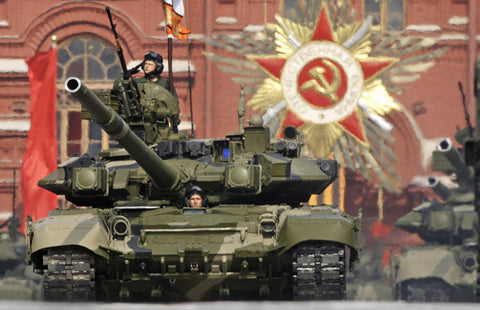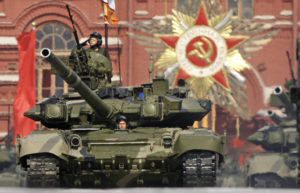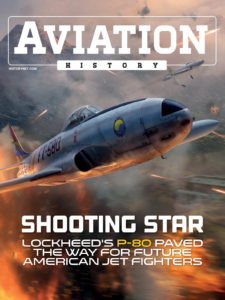
The T-90 Tank: Russia’s First Main Battle Tank

When Russia launched its “special military operation” into Ukraine on Feb. 24, 2022, its offensive was spearheaded by tanks, primarily drawn from its Soviet-built Cold War stocks of T-72s and T-80s. Two months later, however, a newer tank was spotted among their forces moving in Kharkiv Oblast. Designated the T-90, it was reputedly more advanced … as one might have expected of the first tank to enter service since the Soviet Union broke up.
SOVIET LEGACY
When the Cold War ended in 1991, the Soviet army had three main battle tanks, similar in appearance and general conception but differing in their level of technical advancement. The simplest and least expensive was the T-72, of which 22,096 were built at the Uralvagonzavod Ural Rail-car Plant, or UVZ, in Nizhny-Tagil and the Chelyabinsk Tractor Plant between 1973 and 1990. The most advanced, the T-64, proved to be ahead of its time but also both unreliable and dangerous, having an auto-feed for its main cannon that gained a reputation for devouring the left arms of careless gunners. By the time the T-64’s technical quirks were sorted out, the city that manufactured it, Kharkov, had been renamed Kharkiv, and it became a mainstay of the Ukrainian army.
Further up the evolutionary ladder from the T-72 — but less sophisticated than the T-64 — was the T-80, of which 7,066 were built in Leningrad’s Kirov plant and the Transmash plant in Omsk from 1976 to 1990.
GET HISTORY’S GREATEST TALES—RIGHT IN YOUR INBOX
Subscribe to our Historynet Now! newsletter for the best of the past, delivered every Wednesday.
REBRANDING AFTER THE USSR
After the Soviet breakup, only the UVZ and the Transmash plants were still operating, kept afloat by modest production orders and export to foreign countries. From these roots the Russian army ordered a new type, essentially an evolutionary upgrade of the T-72. Designated the T-72BM, it incorporated the 1A45 Irtysh fire-control system from the T-80 with the latest in reactive armor. Further improvements led to acceptance by the Russian Ministry of Defense on March 27, 1991.
Because of the poor performance of T-72s in Iraqi service during Operation Desert Storm and its likely effect on international sales, the builders redesignated the newest production model as the T-88, then changed it again on Oct, 5, 1992 to the T-90, to suggest a new tank for a new decade. When its chief designer at UVZ, Vladimir Potkin, died in 1999, the tank was unofficially nicknamed the Vladimir (the current irony of that name can only be appreciated with the benefit of hindsight).
Recommended for you
OLD TaNK IN NEW CLOTHES
For all the hype, the T-90 is essentially a T-72 packed with a new generation of technology already familiar to its Western counterparts. Its 48 metric tons are powered by a 1,130-hp V84S2F V-12 diesel engine, which gave it a road speed of 37 miles per hour — slower than the T-72 or the turbine-powered T-80 but more economical and reliable than either. Armament consists of a 125 mm 2A4M5 smoothbore cannon with 40 rounds, as well as a coaxial and a flexible turret-mounted 7.62 mm PKTM 6P7K machine gun. As with its predecessors, the crew consists of a driver, a commander and a gunner operating a still-hazardous auto-loader to fire seven rounds per minute. The range is 340 miles.
The most touted components of the T-90’s armament are its defenses. Its welded turret includes a frontal cavity for mounting a laminate of 20 modules of nonenergetic reflective armor, or NERA, in addition to which the tank is covered with Kontakt 5 universal reactive armor, or UDZ, which pre-explodes to degrade the performance of antitank warheads. Additionally, the tank’s Shtora 1 (“Curtain”) antimissile protection system, first installed on the T-80UK, combines TShU-17 infrared dazzlers on either side of the main gun to disrupt an antitank missile’s guidance system with a tracker that activates antilaser smoke emitters to confound the missile’s infrared, while turning the tank and its gun 3.5 to 5 degrees to directly face the oncoming threat.
POOR RESULTS IN UKRAINE
As of 2018, more than 2,700 T-90 tanks or vehicles built on its chassis have been produced for the Russian army, as well as several former Soviet republics, India and Algeria, among others. Some 100 are believed to have been deployed to the eastern offensive in Ukraine, but for all its touted innovations, the T-90 has been doing little better than the T-72s and T-80s that it has joined there.
First contact was reported on April 25, when Ukrainian infantry encountered a T-90 outside of Kharkiv and destroyed it with a Javelin antitank guided missile, along with an MT-LB prime mover and an infantry fighting vehicle that accompanied the tank.
While a single encounter is nothing from which to draw general conclusions, the outcome has parallels with the fates of scores of the T-90’s predecessors. For one thing, the electronic counter weapons have not worked consistently. For another, the American FGM-148 Javelin, German Panzerfaust 3 and other antitank missiles have tandem warheads, one to pre-detonate the active armor and the second to penetrate the tank’s hull. A third factor is an option in the Javelin’s repertoire to turn upwards as it approaches its target and then dive almost vertically on it from above, where the armor is thinner.
A final weakness is tactical: a penchant of the Russian tankers to advance independently, rather than in concert with accompanying infantry. Given the way Soviet combined-arms tactics had been perfected by the end of World War II, this retrograde tendency seems inexplicable, but it has denied the Russian tanks, regardless of model, critical infantry support and left them vulnerable to Ukrainian tank-killing teams.
How the T-90 performs in future remains to be seen. It will, however, take some learning on the part of its crews to improve its performance over that first encounter.
historynet magazines
Our 9 best-selling history titles feature in-depth storytelling and iconic imagery to engage and inform on the people, the wars, and the events that shaped America and the world. Sale! Save $7.99 on your subscription today!









